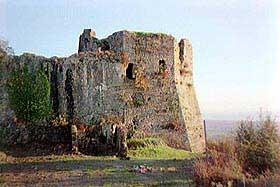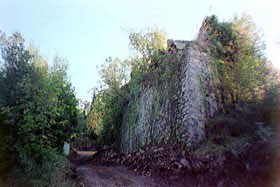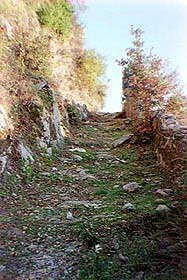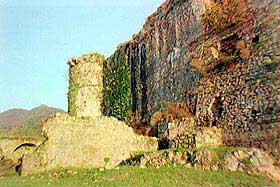Aghinolfo Castle
|
 |
| The curtain of connection between the keep and the round tower of Southwest. | The Mastio (keep), the most ancient part of the castle, with its octagonal form. |
The castle of Aghinolfo rises above the country of Montignoso, around three kilometers south from the center of the city of Massa in the northwest of Tuscany.
Click here for more Photos
Montignoso is one of the least wide communes of the Lunigiana but has been always interested by episodes of historical relief, thanks to its position on the top of a hill from which is possible to dominate the whole underlying valley, crossed by the homonym stream, and to have a good control on the Tyrrhenian coast, that is only four kilometers far.
 |
| The Northeast rampart, limit of the third curtain wall. |
The Castle, is first mentioned in documents of the year 753 A.D., when the Longobard king Astolfo made gift to one of his brother-in-law, the abbot founder of the abbey of Nonantola near Modena, of a piece of land in this area. From the name 'Aghinolfo' came out the clear Longobard origin of the castle, even if it's not sure that its foundation was been effected by the King in person or by a vassal of him, while it's certain that the zone of Montignoso belonged at that times to the crown. Certainly the castle was the most powerful of the valley and shelter for all the populations of the zone in case of danger. Clearly traces of the fortification of that time haven't yet remained, having it been reconstructed many times in the following centuries.
The descendants of Aghinolfo remained in possession of the castle up to year 1376; subsequently the fortification passed to the city of Lucca, that provide the reparations and necessary improvements, for making it a strong outpost against the gangs formed by the soldiers of fortune and the various Republic enemies that infested the area, were performed.
Thanks to the writings of Giovanni Sforza, historian of last century, we have an exact description of the aspect of the castle in 1494, when it was given to Charles VIII king of France. On the fortification rose two tall towers, calls one 'tower of S.Francesco' and the other 'of S.Paolino', and the walled area was extended for around an hectare. This area was divided in three fortified enclosures.
 |
| The road, excavate in the rocks, that leads from the second inner ward to the core of the castle. |
In the first ward were 43 buildings, used as refuge by the inhabitants of Montignoso during the periods of war or as storehouses in time of peace. In the second enclosure, that was accessed through a drawbridge, there were other 87 houses while in the third and last, on the top of the hill, rose up the core of the fortification. This was constituted from a big octagonal tower, the 'Mastio' or keep, connected to a round tower by a stone curtains. Between the endowments of the castle there were a big cistern that collects rainwater and provided water supply for the fortress, a mill and a secret passage that brought outside from the tower.
It doesn't result that the mighty fortification has been ever conquered, but the lack of works of maintenance and the years of abandon have reduced it in a ruinous state. In the 16th century the malaria struck harshly the zone and caused a strong decrease of the population, but the castle suffered the hardest damages from the 1799 when, after it was abandoned by the Lucchesi in consequence of the Giacobine invasion, the inhabitants began to steal the wood of the beams, of the doors and windows and the bricks of the curtain walls to use them in their own houses. Some time after the new Lord of Lucca, Carlo Ludovico di Borbone, bought the castle with the intention to restructure it, but this remained only an intention ever put in work. Today we are still able to admire the mighty ruins on which fortunately from the autumn of 1998 started an important work of restorations.
| More Photos |
| Back to Homepage |
| Back to Castles Index |


